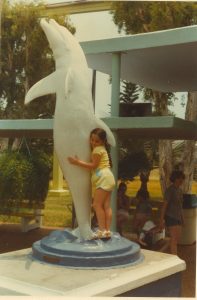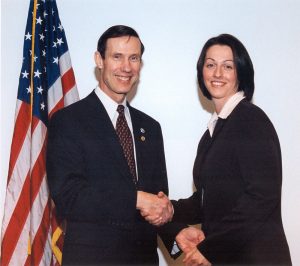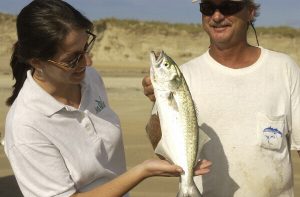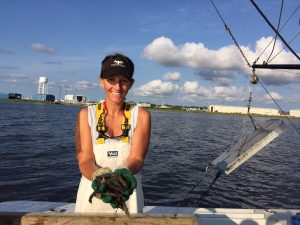By DIANA HACKENBURG
Posted April 25, 2016

Hugging a dolphin statue at the Miami Seaquarium, Mirabilio displayed her love of marine life from an early age. Courtesy of Sara Mirabilio.
Sara Mirabilio may not have grown up on the coast, but that did not prevent her from developing a fascination for the ocean. Her rural New Jersey surroundings did impart, however, a passion for cooperative extension.
“I always looked forward to the Sussex County Farm and Horse Show, and as a 4-H member, I earned several blue ribbons,” Mirabilio proudly recalls. “It also meant I understood, even as a young student, how scientific research and new knowledge could be applied to agriculture through farmer education and outreach.”
This understanding, and her passion for marine life, drove Mirabilio to study marine science at Long Island University’s Southampton College. After earning a master’s degree from William & Mary’s School of Marine Science at the Virginia Institute of Marine Science, she felt confident in her understanding of marine resources and research.
But, she wanted to figure out how to translate science into policy and action. She gained that experience firsthand in 2002 as a John A. Knauss Marine Policy fellow with the Coastal America Partnership and the NOAA Science Advisory Board.
“It takes a great deal of skill to engage coastal residents, businesses and community leaders to frame research questions with scientists that create outcomes that are both scientifically sound and applicable to real-world practice. The Knauss fellowship instills awareness of how people use scientific information to make decisions, and how to stay neutral when communicating complex, sometimes controversial, issues,” Mirabilio explains.

In 2002, then administrator of NOAA retired Navy Vice Admiral Conrad C. Lautenbacher, Jr. presented Mirabilio with a certificate in honor of her Knauss fellowship. Courtesy of NOAA.
During her fellowship, Mirabilio heard then National Sea Grant Extension Director, Jim Murray, explain marine extension – a parallel to agricultural extension. Sold on the idea as her career choice, she started applying post-fellowship only to Sea Grant extension jobs around the country. In August 2003, she joined North Carolina Sea Grant where Murray had spent many years as extension director before he moved to the national office.
In her more than a dozen years with Sea Grant, she has persistently worked to build bridges between science and fishermen – commercial and recreational alike. “There exists a legacy here, for hundreds of years, of harvesting the bounty of the sea, leading to coastal communities rich with maritime traditions,” Mirabilio describes. “How do we strike the necessary balance between economy and resource protection?”
Jack Thigpen, extension director for North Carolina Sea Grant commends Mirabilio’s hard work. “Sara has played for playing a key role in providing expert assistance to the state’s commercial and recreational fisheries. She also has for several years coordinated our fellowship program, which has been recognized for its success recruiting, training and promoting fellows, especially for highly-competitive Knauss program.”
In 2015, Mirabilio received the North Carolina Coastal Federation’s Pelican award for her “enthusiastic and inspired leadership with coastal restoration initiatives.” Previously, she received an N.C. Governor’s Conservation Achievement Award for Natural Resources Scientist of the Year in 2011, and an Outstanding Achievement Award from the South Atlantic Marine Extension Network in 2007.
Mirabilio is a graduate of, and for the last 10 years, an invited instructor for the Natural Resources Leadership Institute at North Carolina State University. Her contributions to the institute were honored with an award in fall 2015.
The following interview has been condensed and edited.
What was the general focus of your Knauss fellowship?

Upon joining North Carolina Sea Grant in 2003, Mirabilio immersed herself in the work by talking to anglers at local events like the Cape Hatteras Anglers Club Invitational Surf Fishing Tournament. Photo by Michael Halminski.
For the first six months, I worked with the Coastal America Partnership, a unique alliance of federal, state and local agencies, as well as private organizations, working together to protect, conserve and restore the nation’s coastal and marine ecosystems, and to make coastal communities more resilient. It is a way of doing business that leverages partner resources to accomplish coastal and marine system conservation and restoration goals that otherwise could not be accomplished by individual parties.
The program office, located in Washington, D.C., coordinates efforts between federal agencies and the private sector through the Corporate Partnership and Coastal America Learning Centers. I helped track the Corporate Partnership projects, organizing and updating over 100 project files and fact sheets, as well as managed the 2002 Coastal America Awards program, including the project evaluations and award ceremony.
The second six months, I was placed with Mike Uhart, executive director of the NOAA Science Advisory Board. Known as the SAB, it is the only federal advisory committee responsible for advising the under secretary of commerce for oceans and atmosphere, also known as the NOAA administrator, on long- and short-range strategies for research, education and the application of science to resource management and environmental assessment and prediction. As a support specialist, I assisted the Board with helping NOAA maintain a complete and accurate understanding of scientific issues critical to the agency’s mission.
Please share a highlight or an accomplishment from your time as a fellow.
I aided NOAA-wide coral research coordination for the Office of Scientific Support within NOAA Research under Russell Callender, himself a former Knauss fellow, and also the previous assistant director of Virginia Sea Grant.
How do you apply the experience and skills you gained as a Knauss fellow to your current position and overall career?
I work to make Sea Grant science understandable and useful to our coastal communities. This is pretty much what executive Knauss Fellows do but for a different audience: policymakers and elected officials.
I also was fortunate to work on a wide range of marine policy issues, as well as with both intra- and interagency work groups, which provided me additional perspectives on resource management issues. That experience enables me to better engage diverse stakeholders, including those with differing viewpoints, every day in my current job as a fisheries extension specialist.

Mirabilio spends much of her time as a fisheries extension specialist in the field. Here she is working up the catch on a shrimp boat in 2015. Photo by Micah Daniels.
What have been the greatest opportunities that have come out of your Knauss fellowship experience?
The fellowship is valuable far beyond the work experience it provides. It offers a system of support, opportunity and exchange among alumni, many who are now leading environmental practitioners throughout the United States and in numerous foreign countries.
Would you recommend others apply for this fellowship? Why?
Yes! Besides the above reasons, the fellowship helps develop a lot of personal skills: self-reflection and self-awareness, leveraging strengths, stretching outside one’s comfort zone and learning from experiences.
What surprised you most about your experience as a fellow?
Despite how many Knauss alumni hold leadership and supervisory positions with NOAA, I nonetheless was surprised by the empowerment given to fellows — the freedom, trust, autonomy and encouragement to carry out high-level, big-impact policy and budgeting tasks.
What do you like best about your current position?
That I can wear flip-flops and shorts to work! Actually, I’ve never had a more challenging job. Every day brings a new issue. I get to innovate and cultivate research and outreach projects that stretch me, making me a better scientist and communicator.
It is not easy to see how science, technology, training and education can combine to move an issue forward, and success stories are few and far between. But it is a great feeling when we can work from the bottom up with stakeholders on a project to develop something with a broad industry or community impact.
North Carolina has placed 71 students in fellowships through the Knauss program, among the highest in the Sea Grant network. Former fellows hold leadership positions within the government, private businesses and nonprofits coast to coast. Explore North Carolina’s branch of the alumni network and learn more about their unique experiences by visiting go.ncsu.edu/where-are-they-now.